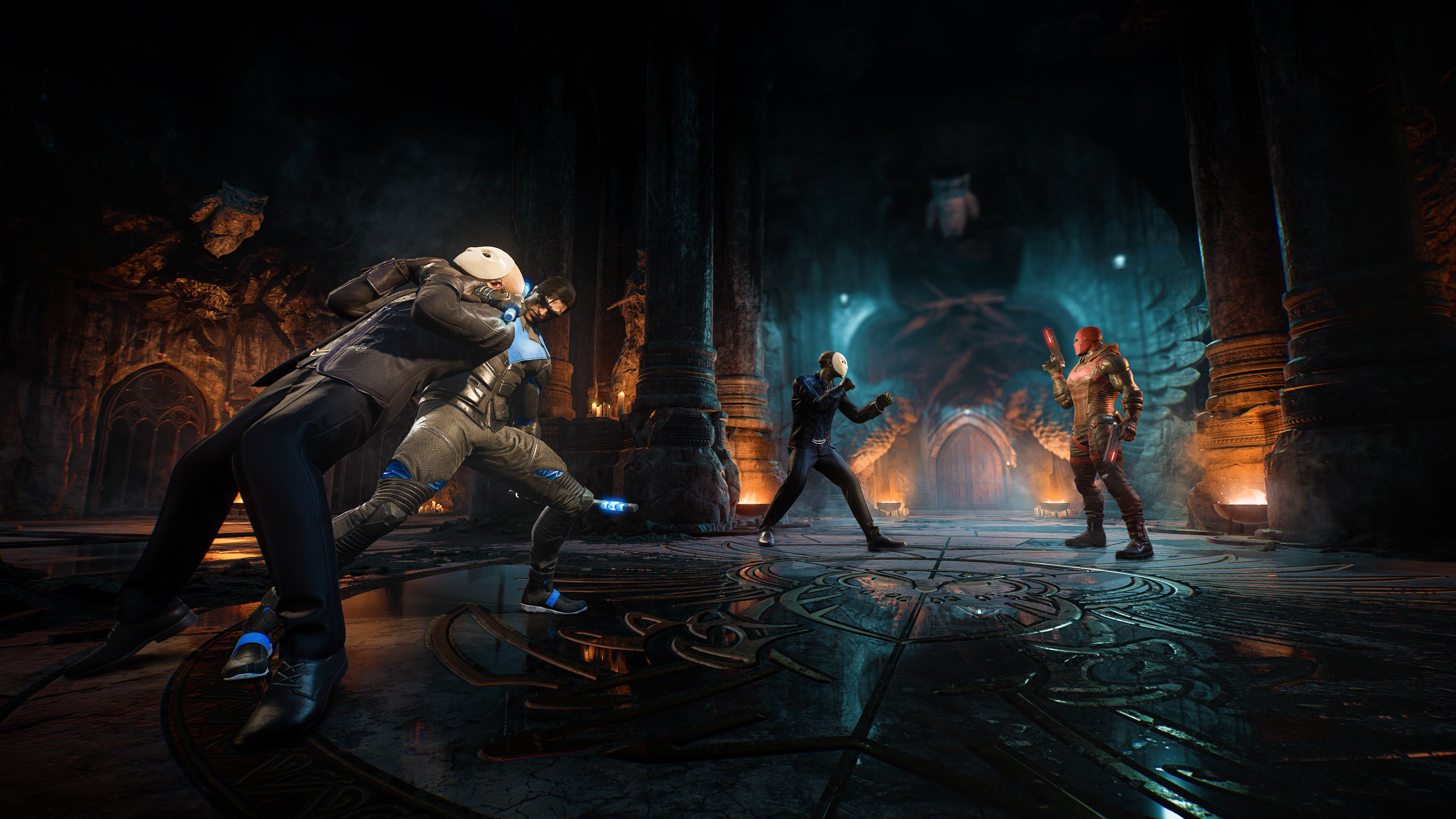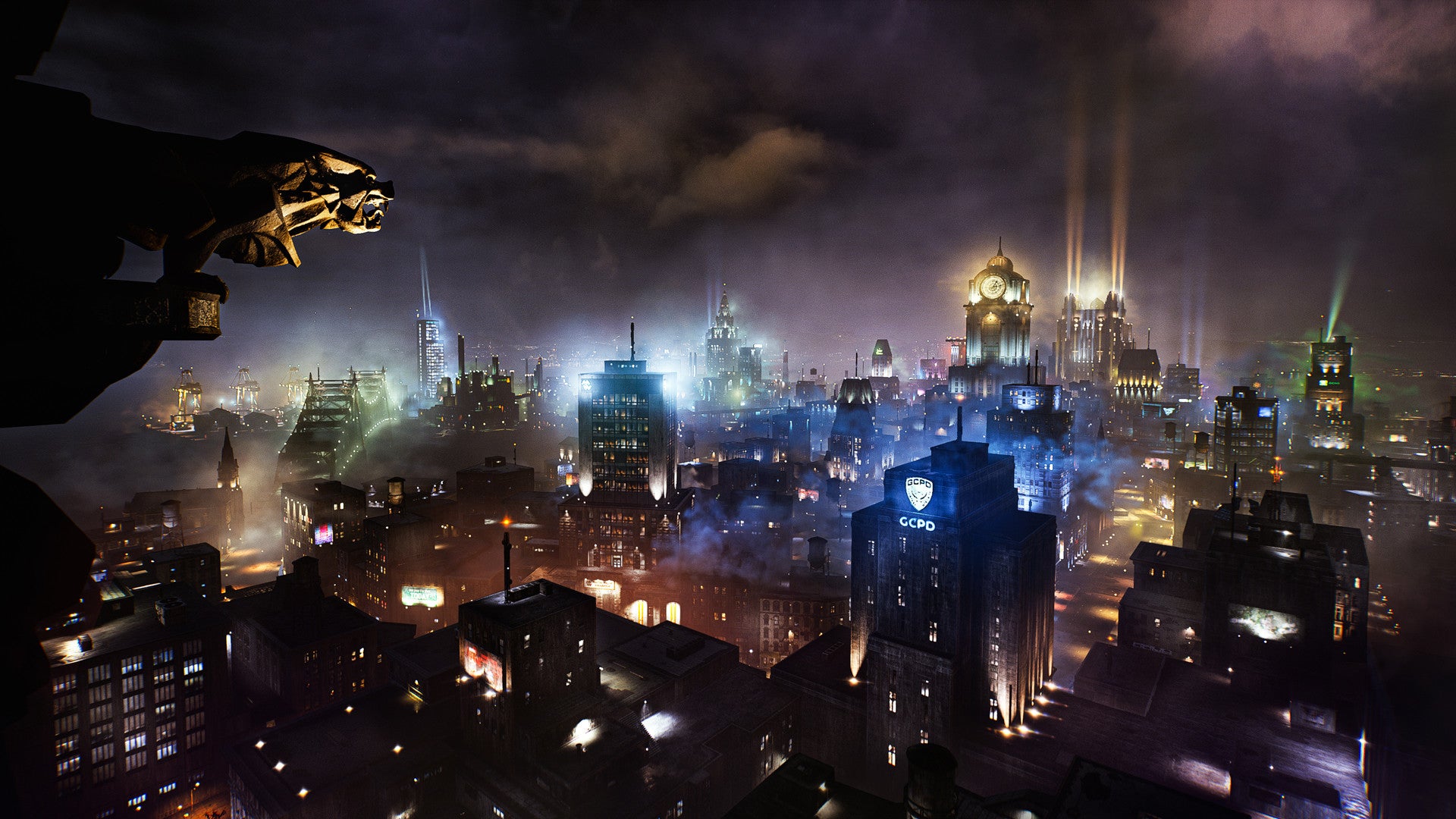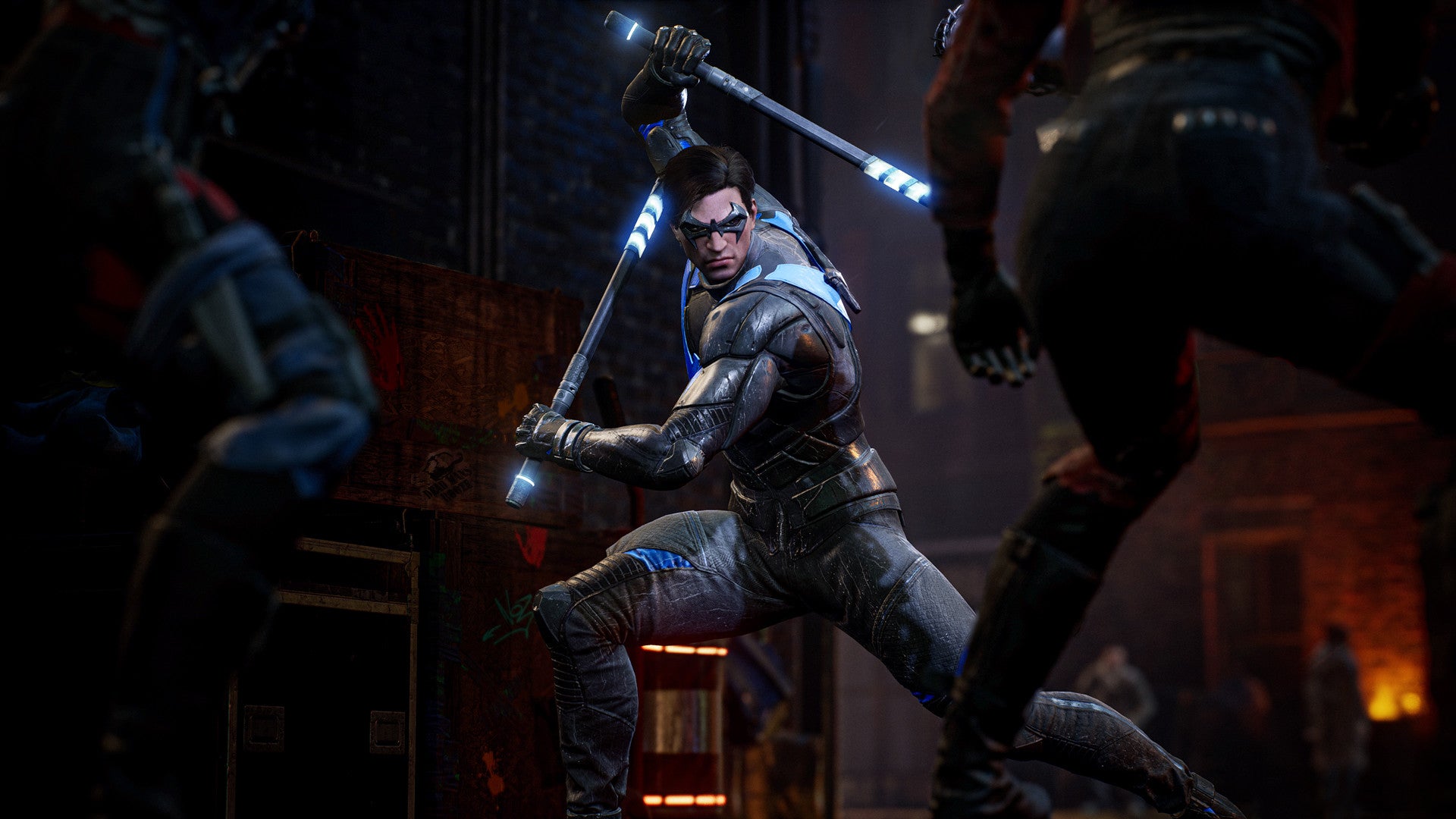I love a concealed door. I absolutely cannot get enough of them. Not just for the theatre of the opening mechanism, the gasp as an unexpected vista is created, but for the kinds of movies and literature that require concealed doors and the people who own them. And testify: this is one of the ways that Gotham Knights has made me pretty happy. For all its sins, for its shortcomings, low frame rates on consoles, bland open-world stuff and predictable plotting, for all of that, during the middle act it is absolutely the high water mark for concealed doors in video games. Nobody else can touch it. Barely a scene goes by in which a hidden switch is not discovered or a series of piano keys pressed, to send an oil painting through the floor or a see a section of Spanish tile transforming itself into a staircase leading down into the earth. What is all this sweet work worth? Gotham Knights has disappointed a lot of people prior to its release by being a Batman game without Batman in it. Batman’s dead, baby! He doesn’t make it through the opening cut-scene. What’s the fun of a Batman game without Batman, in which you get to pick between the remaining elements of the Bat-family for your kicks? The fun, I had hoped, lay with the fact that if Gotham Knights can’t be a Batman story, it can at least be a Court of Owls story. I love the Court of Owls. The Court is a secret society created by the writer Scott Snyder for a deeply memorable Batman arc a while back. The idea was simple: rather than pit Batman against another gimmicky villain, why not pit him against an urban myth. The Court is as old as Gotham - as old, it is teased with Pynchonian flair, as America itself. It’s a secret society that controls everything but has tricked people into thinking that it doesn’t exist. It’s a conspiracy theory, centuries old. It’s a playground rhyme of questionable provenance. How do you punch that? Well, if Gotham Knights is anything to go by, you start by tracking down a bunch of hidden doors. But we’ll get to that. We’ll take our time. Because Gotham Knights takes its time to get to the Court too. Let’s go through the basics, and then the problems, and then end on everything that it turned out that I sort of loved about this game. Firstly, you absolutely do not play as Batman. Instead, over a suite of missions, you pick between Batgirl, Robin, Nightwing, and Red Hood. The game plays out as a series of evening patrols: you choose a hero for the night, head out to do a bit of side-questing, which generally involves finding street gangs doing something nefarious, and then eventually a main mission opens up. Instead of Batman, you get aspects of him. Batgirl is good with tech and can pull off the Beatdown move, alongside lamping people with something that looks like a tuning fork. Robin is angled towards stealth, when he isn’t spinning his bo staff at enemies. Red Hood is a heavy brawler who also shoots people with non-lethal guns. I know right. And Nightwing, I feel, is the all-rounder, balletic and fast and flexible enough to support any way of playing. Nightwing’s also completely brilliant to hang out with, but we’ll get to that. Yes, I missed Batman. Mainly I missed his cape, allowing for flying and swooping around the city. (That said, it’s worth mentioning that you can unlock rather entertaining transport modes for each character by completing Knighthood quests, and these mean you can escape from relying on ziplines and the bat cycle.) I missed his stately menace when moving, too. Batman, particularly in the first Arkham adventure, made for a more close-up superhero game. The camera simply couldn’t get enough of his size and presence, so everything else was close-up too as we leaned forward, moved in. Gotham Knights feels pulled back - we’re smaller and the people we’re fighting are smaller too - MMO mobs almost, not least because health bars are present and immediately become the only thing that draws the eye and all but erases the great animation on display. Stupid health bars! Actually, let’s talk about combat here. Yes, it’s not as good as the Arkham games, but the more I played the more I realised that was also an unhelpful way to think about it. Gotham Knights has taken things from Arkham’s combat - the slow-mo finishers that end a fight and that sort of bright void of sound that erupts when you really connect with someone - but it’s not the same thing. Arkham would stop everything for combat: the camera moved, and then the mob gathered around tight. Batman sort of rolled between foes, whacking one, then another, then another. It was oddly democratic brawling. It reminded me of those tournaments where Kasparov or whoever is surrounded by a ring of lesser chess geniuses, and he just goes round in circles, moving a pawn here, a bishop there. Biff! Pow! This doesn’t really work in Gotham Knights, and it took me a while to realise why. For one thing, enemies don’t crowd in as eagerly, and there often aren’t quite as many of them at any one time. For a large part of the game at least, brawls have moved from set-piece to filler. You’ll be out on patrol and you’ll stop to fight three of these baddies to break up a long commute, or you’re deep in a mission and the room will briefly flood with thugs. There’s more room, everyone’s more scattered, they’re more likely to have specific roles in combat. Crucially, I found it easier to focus on specific enemies and take them down in one go rather than let the cadence of counters carry me around the mob in the grand stirring motion of old. The same is true for stealth - it’s still there, it just doesn’t work quite the way you remembered it. This is because it’s almost always folded into action here. In Arkham an enemy with a machine gun was really the end of you if you tried to brawl with them. Here, they’re just part of the flow of combat. So rather than those spatial puzzles where you’d lurk in the shadows for what felt like hours until eight guards were whittled down to no guards, here stealth will be an option for part of a brawl, generally the first part. I’ll be stealthy until I get spotted. I’ll take down two guys, stumble into open view, and then I won’t retreat to the shadows and allow people to reset, I’ll just brawl it out. In a way it reminds me of the classic Halo encounter: whack, whack, then anything goes. Instead of all that Arkham stuff, you get each character’s skill trees, each character’s special weapons, like Red Hood’s non-gun guns, and each character’s momentum skills. These are unlocked by doing things in the open world, and they’re special attacks that are charged up by dealing damage and then cashed out in chunks. Nightwing might do a sort broom-sweep of electrical ice, for example, while Robin could spin the Bo stick like a plane propeller and just walk it into baddies. This stuff is fun, I think, and combined with the quirks and powers of each character - Red Hood’s guns are a silly idea, but I did enjoy the impactful ranged options they gave him - I started to think of Gotham Knights as being more like a traditional action game, maybe one that has learned a bit from the Platinum classics. Target prioritisation is key, particularly when you have huge baddies with freeze guns or drone guys or distant snipers. Elemental attacks are something to think about. Movement is a bit of a bodge - where Batman would flow between punch to kick, his family often slide along the ground a bit - but it’s also key to a game that spawns enemies in interesting chunks of the world map and wants you to think about how to use the environment. That map! The map itself is a bit of a downer - at least on the surface. I’ve spent hours in Gotham Knight’s Gotham now, zipping around on my bike, grappling the rooftops, taking down street fights and busting up a really surprising amount of organ donor thefts, but I’m still trying to get a sense of what this version of Gotham actually is. It’s suitably grim at least, with each part of the city dominated by a gang - everyone’s in a gang here; even the cops are a gang, which suggests Gotham Knight has learned at least one thing from Marvel’s Spider-Man. There are familiar names on some of the signs for comic book fans, and Anton Furst’s influence lives on in the statues, but otherwise it can be a rather anonymous urban night you’re exploring. Landmark buildings stand out somewhat awkwardly as they’re lavished with care but mounted in neighborhoods of filler real-estate. It can occasionally feel like these landmarks have been digitally added after the production moved to shoot in Vancouver because of the tax breaks. (Granted, it would hardly be the first time a superhero outing has made that calculation.) Over time though I did start to see the beauty in it a bit. The use of up- and down-lighting on sheer skyscraper facades suggests that Ferriss’ Metropolis of Tomorrow was a touchpoint, and there are moments where the cobbled streets reflect the lamplight and the gargoyles and gothicry leer in and I realise that Gotham was perhaps as inspired by Ripper London as it was Chicago and New York. This over-world is filled with side-quests, whole side-villain mini-outings which I won’t spoil, and plenty of busywork to do. It also sets the pace for the main adventure, as between story missions you’re encouraged to break up small crimes and learn clues that allow you to tackle bigger premeditated crimes. These in turn are procedurally placed around the map and make the whole thing feel even more like an MMO than it did already. A crime scene puzzle here, an armoured car encounter there. Long after the campaign is done, I’m still playing this stuff. But crucially, this is only half the city. To return to a favourite quote, there is another world, but it is in this one. Here come the owls again. Main missions follow the Owls and their Court down beneath Gotham more often than not, where there are mines and secret labs and society churches and all kinds of wonderful stuff. Here, Gotham Knights really finds its footing in terms of world-building, both with the interiors of the lavish top-side buildings that the Court owns and the strange places they burrow down towards. Most of the memories I’ll take away from this game are of being deep underground and encountering odd things: weirdos in masks, a new and brutally quick kind of enemy, a towering sense that all of Gotham is built on something ancient and bizarre and deeply villainous. It’s a reminder that Batman was not just an urban superhero from the 1930s - it was built in part on weirdness and Romanticism. What a muddle this game is. Playing it over the past week has been looking past a series of issues large and small, from the No-Batman thing, the bland overworld thing, the somewhat botchy combat thing, the 30fps-on-consoles thing, and even more serious stuff like the clumsiness with which it has handled the disability of one of its protagonists. There is a lot about this game that is suboptimal, that needs explaining, that exists to tie you in knots when you try to talk about it. But also this: the truth is I often had fun with Gotham Knights. And I always looked forward to coming back to it. In retrospect it makes a little more sense. Partly the fun I had is simply because of the elbowy cludge of systems at the heart of the game. It’s been fun to pick between four characters with four separate upgrade trees each, even if a lot of the upgrade trees aren’t that brilliant. It’s been fun learning how to coax premeditated crimes out of the map, literally bashing clues out of low level opponents until they lie on the ground around them like spilled popcorn. It’s been fun to stumble across a menu by mistake and realise that there’s a whole loot game here, disguised by the fact that most of the pick-ups you win in fights don’t look like they’re that interesting. But some of them are loot! And you can also craft more loot. So you can deck out each character with clothes and new weapons that improve their base stats. (I love this: I once created a Nightwing outfit that was supremely powerful, but simultaneously so deeply hideous I couldn’t bring myself to wear it.) It’s been fun to dabble in co-op too. Pre-release there aren’t many people playing, but I’ve had four co-op experiences that have all been intriguingly odd. You can only pair up with one other person - I gather there’s a more involved mode on the way but I couldn’t play it during review - and then you have the whole of the map to explore, and get this: you don’t have to stick together. This online mode is absolutely packed with Batgirls currently. In one game I followed a Batgirl around the city, always arriving just after she’d cleaned everything up each time. In another, I was immediately wiped out by a massively overpowered enemy because this particular Batgirl I was matched with was at a much higher level. The best game I had was when the Batgirl du jour and I did our own things and only occasionally did events bring us together. You? Here? The idea behind this mode is that you mash stuff up as a team, and use special combo moves and synergies. I haven’t had that yet, but Gotham Knights is surprisingly good at exploring the high-school social awkwardness of being in a superhero city where there are other superheroes you don’t really know very well. All this is fun. But for the thing I really love about Gotham Knights we have to focus in on Nightwing, also known as Dick Grayson. And we have to open his emails. I will admit, I had never thought about Dick Grayson very much. But it turns out he’s brilliant. He’s a goofball, a bit of a himbo, and Gotham Knights absolutely embraces this in its characterisation. It’s surprisingly light touch stuff: he’ll say funny things in combat, moan about the work he has to do and lark about back at the hub that the team all share. (That’s right! As well as swapping out Batman and trading his awesome car for a motorbike, your hub is no longer a cave but a kind of flatshare, albeit a pretty sweet one with a Spy Hunter cabinet, and a kitchen diner. Dual aspect clock faces, minimum 20 million in the current market, but it’s probably riddled with asbestos.) Anyway, as well as following Dick Grayson on missions and forcing him to wear astonishingly ugly costumes, you can also read his emails. Please do. Reading his emails has been one of my happiest memories in games for years. It seems like such a small thing to remark on, and it is. But it’s a small thing that made a huge difference in terms of the fondness I feel for this odd, compromised video game. Those emails. Fine, here he is talking to the Penguin about the current mission. Here he is worrying about resources, or what the Court is up to and how deep it goes. Story stuff. The underlining of themes. But wait, here he is announcing that there is a criminal among us - someone has stolen the pizza he left in the communal fridge. Here he is - I can’t believe I am typing this - workshopping owl puns with Clark Kent so he can annoy Batgirl. Actually, Grayson isn’t alone in this. I read Robin’s emails last night and he was floating the idea that the Gotham Knights set up a podcast. This charm, most concentrated in the emails, actually exists throughout the fabric of the whole game, through the oddball shouts of the people you zip past on your bike on your way to foil the next organ theft, through set-piece missions including a deeply unusual prison riot, throughout the whole of Gotham itself. Who knows? Like the Court of Owls, this strange unlikely charm underpins everything. And it tells me this: video games are huge undertakings, and when you’re dealing with a massive, billion dollar licence, maybe the people making the games don’t get to make all the decisions and set all the parameters. Maybe they don’t get the budget they need for a truly vibrant open-world. Maybe they don’t get the time to polish the combat and stop people slipping around on the floor. Maybe they have to trade the Batmobile for a bike. But they can add charm. They can throw in a joke here, a funny email there, and leave it all behind a concealed door and wait for you to discover it.



.jpg/BROK/resize/690%3E/format/jpg/quality/75/Gotham-Knights-Red-Hood-(2).jpg)

